#PC Engine (Turbografix-16)
Explore tagged Tumblr posts
Text




Bubblegum Crash! 1991 TurboGrafix-16/PC Engine
#retro gaming#gaming#video games#acquired stardust#bubblegum crisis#bubblegum crash#pixel art#anime#retro anime#80s anime#90s anime#priss asagiri#linna yamazaki#nene romanova#sylia stingray#gifs#pc engine#turbografx#turbografix 16#tg16#nostalgia#90s#1990s#gif#game gifs#cyberpunk#aesthetic#oldtaku#classic anime#old school anime
588 notes
·
View notes
Text

#Neptunia franchise#Animations and Videogames#IF#Personifications#Ideal Factory#Neptune#Planeptune#Goddess#Purple Heart#Fictional version of Sega console#PC Engine (Turbografix-16)#Peashy#Sega consoles#Plutia#Iris Heart#Compa#Humans#Goddesses
3 notes
·
View notes
Text


Peashy
2 notes
·
View notes
Text
Bishoujo Senshi Sailor Moon PC Engine/Turbografix 16 Game Playthroughs
Finally complete! Playthrough and reaction streams of the very rare Turbografx 16/ NES PC Engine Game Bishoujo Senshi Sailor Moon from 1994. It takes place after the Maijaku Arc (the Doom Tree Arc) and is in visual novel format, recorded with the original Japanese voice actors from the 90s anime. It is an addendum to the Dark Kingdom Arc of the 90s anime, closing out the loose ends. This is the fan-translated English version.

Multistreamed on Discord and Piczel.tv for five nights, one for each character. Done in podcast style (meaning you’ll hear our voices and all our corny jokes) Final stream is in two parts and has never-before-seen cut scenes that were not included in the game.
(WARNING: TALK CAN GET NSFW)
#bishoujo senshi sailor moon#sailor moon#senshi x shitennou#sailor moon video game#visual novel#turbografx 16#pc engine#YouTube streams
19 notes
·
View notes
Text
More of a unique shmup is up next. Atomic Robo-Kid

This one, I see the vision, but it is a bit stiff for my liking. I've heard the PC Engine/Turbografixs-16 version is better so I am curious to try it when I get to that system. I do think the pacing of the game is fine just the game feels a bit stiff to play.
2 notes
·
View notes
Text
Hell is terms like ASIC, FPGA, and PPU
I haven't been doing any public updates on this for a bit, but I am still working on this bizarre rabbit hole quest of designing my own (probably) 16-bit game console. The controller is maybe done now, on a design level. Like I have parts for everything sourced and a layout for the internal PCB. I don't have a fully tested working prototype yet because I am in the middle of a huge financial crisis and don't have the cash laying around to send out to have boards printed and start rapidly iterating design on the 3D printed bits (housing the scroll wheel is going to be a little tricky). I should really spend my creative energy focusing on software development for a nice little demo ROM (or like, short term projects to earn money I desperately need) but my brain's kinda stuck in circuitry gear so I'm thinking more about what's going into the actual console itself. This may get techie.
So... in the broadest sense, and I think I've mentioned this before, I want to make this a 16-bit system (which is a term with a pretty murky definition), maybe 32-bit? And since I'm going to all this trouble I want to give my project here a little something extra the consoles from that era didn't have. And at the same time, I'd like to be able to act as a bridge for the sort of weirdos who are currently actively making new games for those systems to start working on this, on a level of "if you would do this on this console with this code, here's how you would do it on mine." This makes for a hell of a lot of research on my end, but trust me, it gets worse!
So let's talk about the main strengths of the 2D game consoles everyone knows and loves. Oh and just now while looking for some visual aids maybe I stumbled across this site, which is actually great as a sort of mid-level overview of all this stuff. Short version though-
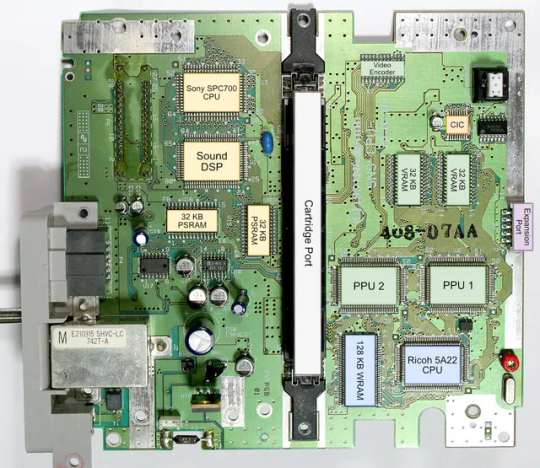
The SNES (or Super Famicom) does what it does by way of a combination of really going all in on direct memory access, and particularly having a dedicated setup for doing so between scanlines, coupled with a bunch of dedicated graphical modes specialized for different use cases, and you know, that you can switch between partway through drawing a screen. And of course the feature everyone knows and loves where you can have one polygon and do all sorts of fun things with it.
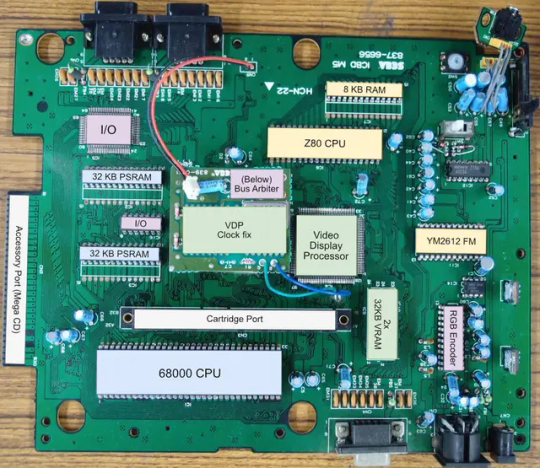
The Genesis (or Megadrive) has an actual proper 16-bit processor instead of this weird upgraded 6502 like the SNES had for a scrapped backwards compatibility plan. It also had this frankly wacky design where they just kinda took the guts out of a Sega Master System and had them off to the side as a segregated system whose only real job is managing the sound chip, one of those good good Yamaha synths with that real distinct sound... oh and they also actually did have a backwards compatibility deal that just kinda used the audio side to emulate an SMS, basically.
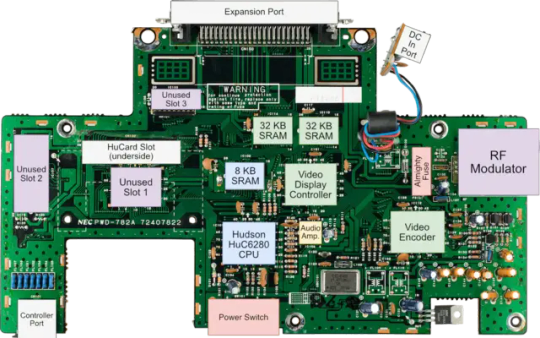
The TurboGrafix-16 (or PC Engine) really just kinda went all-in on making its own custom CPU from scratch which...we'll get to that, and otherwise uh... it had some interesting stuff going on sound wise? I feel like the main thing it had going was getting in on CDs early but I'm not messing with optical drives and they're no longer a really great storage option anyway.
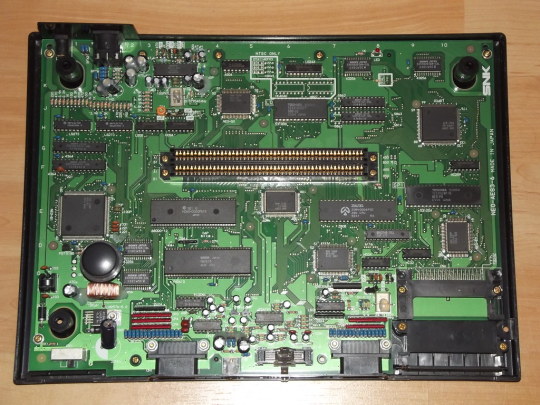
Then there's the Neo Geo... where what's going on under the good is just kind of A LOT. I don't have the same handy analysis ready to go on this one, but my understanding is it didn't really go in for a lot of nice streamlining tricks and just kinda powered through. Like it has no separation of background layers and sprites. It's just all sprites. Shove those raw numbers.
So what's the best of all worlds option here? I'd like to go with one of them nice speedy Motorolla processors. The 68000 the Genesis used is no longer manufactured though. The closest still-in-production equivalent would be the 68SEC000 family. Seems like they go for about $15 a pop, have a full 32-bit bus, low voltage, some support clock speeds like... three times what the Genesis did. It's overkill, but should remove any concerns I have about having a way higher resolution than the systems I'm jumping off from. I can also easily throw in some beefy RAM chips where I need.
I was also planning to just directly replicate the Genesis sound setup, weird as it is, but hit the slight hiccup that the Z80 was JUST discontinued, like a month or two ago. Pretty sure someone already has a clone of it, might use that.
Here's where everything comes to a screeching halt though. While the makers of all these systems were making contracts for custom processors to add a couple extra features in that I should be able to work around by just using newer descendant chips that have that built in, there really just is no off the shelf PPU that I'm aware of. EVERYONE back in the day had some custom ASIC (application-specific integrated circuit) chip made to assemble every frame of video before throwing it at the TV. Especially the SNES, with all its modes changing the logic there and the HDMA getting all up in those mode 7 effects. Which are again, something I definitely want to replicate here.
So one option here is... I design and order my own ASIC chips. I can probably just fit the entire system in one even? This however comes with two big problems. It's pricy. Real pricy. Don't think it's really practical if I'm not ordering in bulk and this is a project I assume has a really niche audience. Also, I mean, if I'm custom ordering a chip, I can't really rationalize having stuff I could cram in there for free sitting outside as separate costly chips, and hell, if it's all gonna be in one package I'm no longer making this an educational electronics kit/console, so I may as well just emulate the whole thing on like a raspberry pi for a tenth of the cost or something.
The other option is... I commit to even more work, and find a way to reverse engineer all the functionality I want out with some big array of custom ROMs and placeholder RAM and just kinda have my own multi-chip homebrew co-processors? Still PROBABLY cheaper than the ASIC solution and I guess not really making more research work for myself. It's just going to make for a bigger/more crowded motherboard or something.
Oh and I'm now looking at a 5V processor and making controllers compatible with a 10V system so I need to double check that all the components in those don't really care that much and maybe adjust things.
And then there's also FPGAs (field programmable gate arrays). Even more expensive than an ASIC, but the advantage is it's sort of a chip emulator and you can reflash it with something else. So if you're specifically in the MiSTer scene, I just host a file somewhere and you make the one you already have pretend to be this system. So... good news for those people but I still need to actually build something here.
So... yeah that's where all this stands right now. I admit I'm in way way over my head, but I should get somewhere eventually?
11 notes
·
View notes
Video
youtube
The games that will be included on the TurboGrafix-16 Mini have officially been revealed! Watch the video above or check the list below.
American games:
Air Zonk
Alien Crush
Blazing Lazers
Bomberman ‘93
Bonk’s Revenge
Cadash
Chew-Man-Fu
Dungeon Explorer
J.J. & Jeff
Lords Of Thunder
Military Madness (Nectaris)
Moto Roader
Neutopia
Neutopia II
New Adventure Island
Ninja Spirit
Parasol Stars
Power Golf
Psychosis
R-Type
Soldier Blade
Space Harrier
Victory Run
Ys Book I&II
Japanese PC Engine games:
Akumajō Dracula X Chi No Rondo (Castlevania: Rondo Of Blood)
Aldynes (SuperGrafx game)
Appare! Gateball
Bomberman ‘94
Bomberman Panic Bomber
Chō Aniki
Daimakaimura (Ghouls ‘N’ Ghosts - SuperGrafx game)
Dungeon Explorer
Fantasy Zone
Ginga Fukei Densetsu Sapphire
Gradius (Nemesis)
Gradius II – Gofer No Yabō (Nemesis II)
Jaseiken Necromancer
Nectaris (Military Madness)
Neutopia
Neutopia II
Ninja Ryūkenden (Ninja Gaiden)
PC-Genjin (Bonk)
Salamander
Snatcher
Star Parodier (Fantasy Star Soldier)
Super Darius
Super Momotarō Dentetsu II
Super Star Soldier
The Kung Fu (China Warrior)
Ys I&II
It’s due to hit stores in March 2020. No price has been announced yet.
4 notes
·
View notes
Note
I followed the instructions to the tee and the patching eventually worked but my computer or the emulator (retroarch) doesnt like it. Like yeah the patching took a while for me to figure out but pc kept freezing. Like not sure whats going on. My point was more that i like that there was another option to getting the game. More companies should do things like this.
You have a kosher version of Syscard3.pce right?
Rondo of Blood needed the Super CD System Card version 3 to run, and freezing/crashing is common with a missing/invalid system BIOS
Also you should probably run it in the PC Engine engine instead of the Turbografix-16 engine if you’re doing that for some bizarre reason
1 note
·
View note
Note
There's a rumour going about that after Nintendo finish with the SNES Classic mini, the next year won't be a N64 classic mini, but instead will be a gba classic mini. I don't put much stock in the rumours. If you could pick any console/handheld (not just Nintendo ones) to get the classic mini treatment, what would you pick? Personally I would like either a gba classic or a PC engine (turbografix-16)
Being honest, I don’t really care too much about the minis. Sure, they’re cute and all, but Virtual Console overall feels better to me, since you actually get to choose the games you get rather than paying for a lot you might not care about, and you can ADD more games. The minis just end up feeling kinda lacking to me in that regard.
1 note
·
View note
Photo

When shit is about to go down on the PC Engine/TurboGrafix-16. Transition is used in all the PC Engine Fire Pro games.
1 note
·
View note
Text

Bubblegum Crash! 1991 TurboGrafix-16/PC Engine
#retro gaming#gaming#video games#bubblegum crisis#bubblegum crash#pixel art#anime#retro anime#80s anime#90s anime#priss asagiri#linna yamazaki#nene romanova#sylia stingray#gifs#pc engine#turbografx#turbografix 16#tg16#nostalgia#90s#old anime#oldtaku#1990s#1991#retro games#animanga#bgc
261 notes
·
View notes
Photo

The Genesis of Our Lives presents: Snatcher!
Release date: November 30th, 1994
That lady on the Konami number was on to something. This is a really engaging game. A quick search for lists of best SEGA CD titles reveals that many agree, with this game appearing in the top five of pretty much any list I’ve found. It’s certainly well-deserved.
Here’s a fun fact I learned recently: the original 8-bit versions of the game ended up taking so long in development that the original ending was left off. When the game was remade for the PC-Engine (a.k.a. Turbografix-16), the team took the time to add in the voice-acting and the proper ending. All further ports of the game, including this one, were based on this port.
Also apparently the game scales the shooting parts’ difficulty depending on how well you do at the firing range. Which means the fact that I ended up being unable to shoot at all in the opening segment due to Fusion not being able to simulate the Justicar makes me the luckiest son of a gun in the world.
Also apparently Neo Kobe Pizza in real life tastes really freakin’ delicious. I have to look into that...
Tomorrow at 2 PM Pacific standard time!
0 notes
Text

Bubblegum Crash! TurboGrafix-16/PC Engine 1991
#retro gaming#gaming#video games#bubblegum crisis#bubblegum crash#pixel art#anime#retro anime#80s anime#90s anime#pc engine#turbografx#turbografix 16#tg16#nostalgia#90s#old anime#oldtaku#1990s#1991#retro games#animanga#bgc#aesthetic#virtual photography#leon mcnichol#daley wong#ad police#cyberpunk#anime games
33 notes
·
View notes
Text
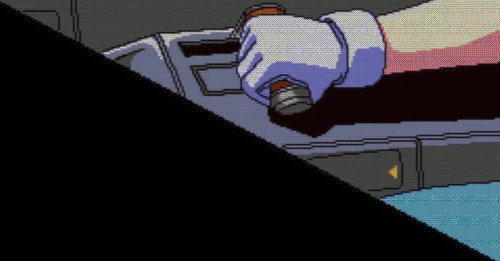
Ginga Fukei Densetsu Sapphire TurboGrafix-16/PC Engine 1995
#gaming#video games#retro gaming#nostalgia#aesthetic#90s#1990s#pixel art#gif#game gifs#ginga fukei densetsu sapphire#sapphire#turbografx 16#tg16#tg 16#pc engine#obscure#obscure media#obscure games#1995#retro anime aesthetic#90s anime aesthetic#shoot em up#shmups#anime style#hudson#hudson soft#caproduction
61 notes
·
View notes